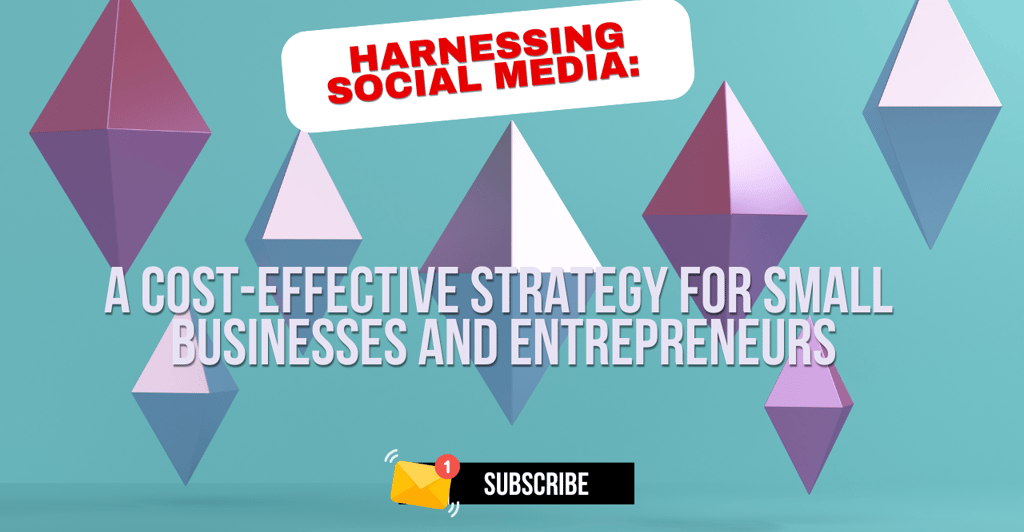Harnessing Social Media: A Cost-Effective Strategy for Small Businesses and Entrepreneurs
Discover how small businesses and entrepreneurs can harness the power of social media to build brand awareness, engage customers, and drive growth—all while keeping costs low.
BUDGET STRATEGIESMARKETINGSOCIAL MEDIAENTREPRENEURSHIP
Agile Mediaz
10/31/20243 min read


Introduction
In the digital age, social media has emerged as more than a tool for connection—it’s a strategic asset for business growth. Small enterprises, solo entrepreneurs, and micro-businesses can now harness platforms like Facebook, Instagram, Twitter, LinkedIn, and TikTok to increase visibility, nurture customer relationships, and drive sales. Unlike traditional marketing, which often requires hefty budgets, social media offers a level playing field. With billions of active users worldwide, these platforms provide unparalleled access to potential customers and the chance to build a reputable brand—no massive budget required.
Why a Clear Brand Message Matters
A compelling brand message is the bedrock of your digital presence. For your brand to stand out and resonate, your unique value proposition (UVP) must be crystal clear: what sets you apart, why customers should trust you, and how you solve their problems uniquely.
Start by defining your brand’s personality: Are you lighthearted and playful, polished and elegant, or bold and edgy?
Ensure visual consistency—maintain the same logos, colors, and fonts across all platforms.
Keep the tone and messaging uniform in every bio, post, and caption.
Engage authentically: reply to comments, spark conversations, and listen to your community.
This kind of cohesive branding helps your small business remain memorable and fosters trust—two vital ingredients for growth.
Leveraging Social Media Analytics for Smart Growth
Every major social platform provides built-in analytics that can guide your strategy:
Demographics (age, gender, location) show who you’re reaching.
Content performance metrics (likes, shares, comments, views) help identify what resonates.
Ad metrics (click-through and conversion rates) reveal what’s working and what needs improvement.
By consistently reviewing these insights, you can refine your messaging, fine-tune your content types, and direct your marketing budget toward tactics that yield results—ensuring smarter investments and greater return.
Cost-Effectiveness: Why Social Media Stands Out
Social media marketing provides a compelling alternative to pricey traditional media like TV ads or billboards. Here's why:
Free and low-cost marketing: Setting up and maintaining business profiles on platforms like Instagram, Facebook, TikTok, Twitter, and LinkedIn costs nothing. You can post, engage, and grow your audience free of financial barriers.
Example: A small boutique posting fashion inspiration, behind-the-scenes moments, and customer testimonials can quickly build an engaged following—without spending on ads.
Organic reach without paywalls: Viral content, authentic storytelling, or clever use of hashtags can dramatically increase visibility without costing a dime.
Example: A local café posting latte art reels and customer reactions might go viral, drawing in thousands of new customers organically.
Affordable and targeted ads: When you're ready to invest, platforms allow highly focused campaigns, optimizing every dollar spent.
Target based on age, location, interests, and behaviors.
Start with as little as $5 per day and scale as needed.
Real-time tracking allows immediate adjustments for better ROI.
Example: A handmade jewelry shop running ads targeting “boho fashion” enthusiasts can ensure their content reaches the most relevant shoppers at a fraction of traditional ad costs.
Building a Strong Digital Presence
A well-defined brand message is the foundation of social media success. Businesses must articulate their unique value proposition (UVP)—what makes them different, why customers should trust them, and how they solve specific problems.
To establish a strong presence:
1. Create a Cohesive Brand Identity
Your brand should feel instantly recognizable across all digital touchpoints.
Use consistent visuals (logo, color palette, typography).
Maintain uniform voice and messaging in bios, captions, and replies.
Always include clear calls-to-action (CTAs)—encourage followers to visit your website, sign up for emails, or make a purchase.
Example: Nike’s iconic “Just Do It” message is instantly recognizable, whether in a post, ad, or product page.
2. Maintain a Content Calendar for Consistency
Planning ahead means staying active and relevant.
Blend content types—add value with behind-the-scenes, testimonials, videos, and infographics.
Utilize trending topics and hashtags to stay discoverable.
Schedule posts during peak engagement times for maximum visibility.
Example: A fitness coach who posts weekly workouts, shares client progress, and hosts Q&A sessions builds a strong and loyal community.
3. Actively Engage With Your Audience
Social media isn’t a one-way broadcast—it’s a conversation.
Respond personally to comments and direct messages.
Use polls or questions to spark discussion.
Host giveaways or challenges to increase awareness and interaction.
Example: A skincare brand asking, “What’s your #1 skincare concern?” invites engagement while gathering valuable insights.


Final Thoughts
Social media is one of the most powerful—and cost-effective—tools available to small businesses today. From building brand awareness and credibility to engaging directly with customers and driving sales, social media provides a growth engine without the hefty price tag of traditional advertising. It’s affordable, accessible, and allows you to compete with much larger brands on your own terms.
Key takeaways:
It’s cost-effective, perfect for lean budgets and startups.
It levels the playing field, giving smaller brands the same reach potential as big players.
It builds trust and long-term loyalty—vital for sustainable success.
Connect
Empowering small businesses through digital marketing solutions.
Explore
Innovate
contact@agilemediaz.net
© 2024. All rights reserved.

